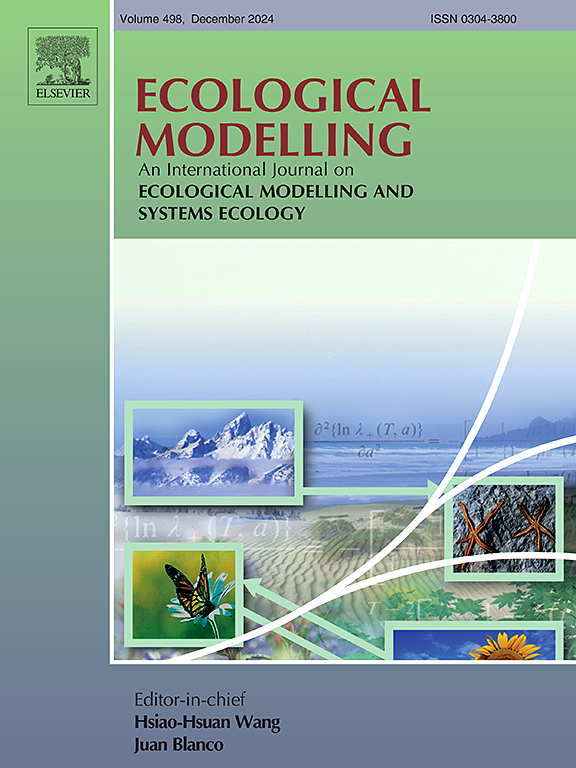Environmental driven changes in tick life history can explain the variation in CCHFV prevalence in the Iberian Peninsula
IF 3.2
3区 环境科学与生态学
Q2 ECOLOGY
引用次数: 0
Abstract
Crimean-Congo haemorrhagic fever virus (CCHFV) is an emerging tick-borne zoonotic disease with a wide geographical distribution and high case mortality in humans. The emerging nature of the pathogen means there is limited understanding of the epidemiological drivers of infection prevalence and regional variation in the risk of pathogen spillover. In this study we develop a mathematical model of CCHFV transmission between ticks and their different hosts to understand how changes in tick birth and tick survival will interact with host density and host composition to determine the incidence of infection in ticks and their varied hosts. A key result shows that CCHFV antibody prevalence in ungulate hosts is sensitive to variation in tick demographic parameters where a 50% variation in tick birth or death rates can lead to ranges of seroprevalence in ungulates. Therefore, environmentally derived changes in tick life history parameters could explain the variation in CCHFV transmission to ungulates observed in the Iberian Peninsula. The model indicates that CCHFV transmission is sensitive to changes in the level of vertical or co-feeding transmission and calls for further studies to determine the importance of these transmission routes. We find that the risk of pathogen spillover to human populations due to an increased density of infected questing ticks is greatest in regions where ungulate seroprevalence is high. Therefore, monitoring wildlife disease status can inform on infection risk to humans and highlights the need for one health policies to manage pathogens that can infect multiple species.
蜱虫生活史的环境驱动变化可以解释伊比利亚半岛CCHFV流行率的变化
克里米亚-刚果出血热病毒(CCHFV)是一种新出现的蜱传人畜共患疾病,地理分布广泛,人间病例死亡率高。病原体的新出现性质意味着对感染流行的流行病学驱动因素和病原体溢出风险的区域差异的理解有限。在这项研究中,我们建立了蜱及其不同宿主之间CCHFV传播的数学模型,以了解蜱的出生和存活的变化如何与宿主密度和宿主组成相互作用,从而确定蜱及其不同宿主的感染发生率。一项关键结果表明,有蹄动物宿主的CCHFV抗体流行率对蜱虫人口统计学参数的变化敏感,其中蜱虫出生或死亡率的50%变化可导致有蹄动物的血清阳性率在0-90%范围内。因此,环境引起的蜱虫生活史参数的变化可以解释伊比利亚半岛观察到的CCHFV向有蹄类传播的变化。该模型表明,CCHFV的传播对垂直或共食传播水平的变化很敏感,需要进一步研究以确定这些传播途径的重要性。我们发现,由于受感染的蜱虫密度增加,在有蹄类血清患病率高的地区,病原体向人群溢出的风险最大。因此,监测野生动物疾病状况可以为人类感染风险提供信息,并强调需要制定一项卫生政策来管理可能感染多个物种的病原体。
本文章由计算机程序翻译,如有差异,请以英文原文为准。
求助全文
约1分钟内获得全文
求助全文
来源期刊

Ecological Modelling
环境科学-生态学
CiteScore
5.60
自引率
6.50%
发文量
259
审稿时长
69 days
期刊介绍:
The journal is concerned with the use of mathematical models and systems analysis for the description of ecological processes and for the sustainable management of resources. Human activity and well-being are dependent on and integrated with the functioning of ecosystems and the services they provide. We aim to understand these basic ecosystem functions using mathematical and conceptual modelling, systems analysis, thermodynamics, computer simulations, and ecological theory. This leads to a preference for process-based models embedded in theory with explicit causative agents as opposed to strictly statistical or correlative descriptions. These modelling methods can be applied to a wide spectrum of issues ranging from basic ecology to human ecology to socio-ecological systems. The journal welcomes research articles, short communications, review articles, letters to the editor, book reviews, and other communications. The journal also supports the activities of the [International Society of Ecological Modelling (ISEM)](http://www.isemna.org/).
 求助内容:
求助内容: 应助结果提醒方式:
应助结果提醒方式:


